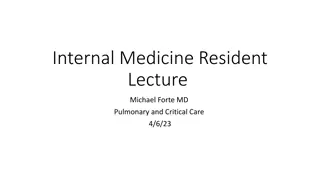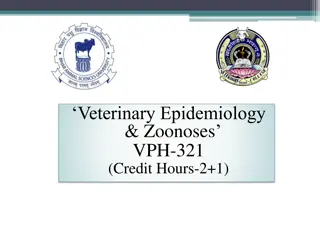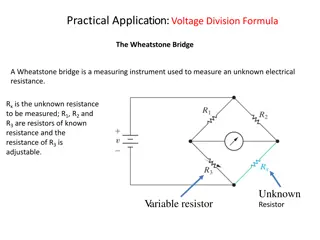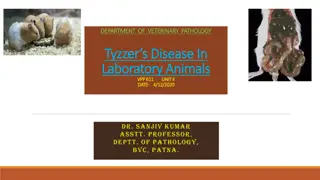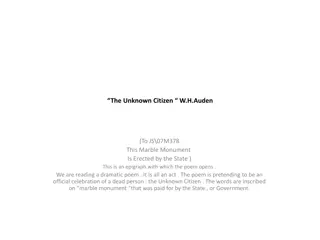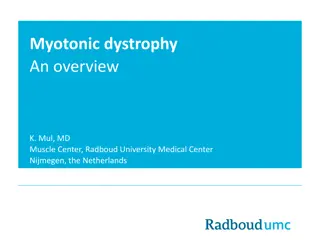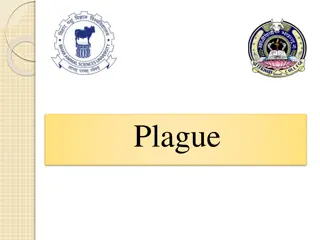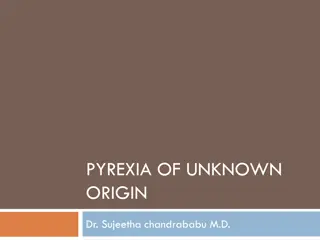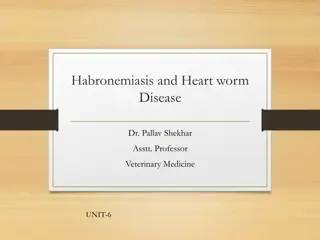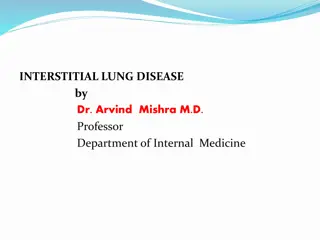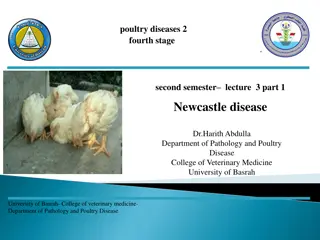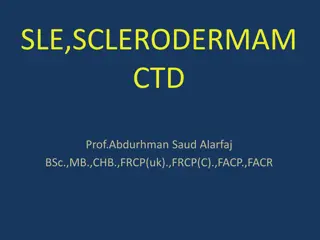Sarcoidosis: Multisystem Disease of Unknown Etiology
Sarcoidosis is a complex disease characterized by noncaseating granulomas in various tissues. It affects all genders and races, with a higher prevalence in younger adults and African Americans. While the exact cause is unknown, genetic predisposition and immune dysregulation play key roles in its pathogenesis. The disease is driven by CD4+ T cells and involves cytokine dysregulation, leading to granuloma formation. Familial clustering and HLA associations suggest a genetic component, and the recurrence of sarcoidosis post-lung transplantation indicates a possible environmental trigger. Investigations into potential antigens have not yielded definitive answers yet.
Uploaded on Apr 15, 2025 | 0 Views
Download Presentation

Please find below an Image/Link to download the presentation.
The content on the website is provided AS IS for your information and personal use only. It may not be sold, licensed, or shared on other websites without obtaining consent from the author.If you encounter any issues during the download, it is possible that the publisher has removed the file from their server.
You are allowed to download the files provided on this website for personal or commercial use, subject to the condition that they are used lawfully. All files are the property of their respective owners.
The content on the website is provided AS IS for your information and personal use only. It may not be sold, licensed, or shared on other websites without obtaining consent from the author.
E N D
Presentation Transcript
II. Granulomatous Diseases A. Sarcoidosis - Although sarcoidosis is an example of a restrictive lung disease, it is important to note that sarcoidosis is a multisystem disease of unknown etiology characterized by noncaseating granulomas in many tissues and organs. - Other diseases, including mycobacterial or fungal infections may also produce noncaseating granulomas; so the histologic diagnosis of sarcoidosis is one of exclusion. 2
Epidemiology - Sarcoidosis occurs throughout the world, affecting both genders and all races and age groups. - There is a consistent predilection for adults younger than 40 years of age - A high incidence has been noted among African Americans (in whom the frequency of involvement is 10 times greater than in whites). - Sarcoidosis is one of the few pulmonary diseases with a higher prevalence among nonsmokers. 3
ETIOLOGY AND PATHOGENESIS - Although the etiology of sarcoidosis remains unknown, several lines of evidence suggest that it is a disease of disordered immune regulation in genetically predisposed persons exposed to certain environmental agents - Immunologic abnormalities in sarcoidosis suggest the development of a cell-mediated response to an unidentified antigen and the process is driven by CD4+ helper T cells. These abnormalities include: 1. Intra-alveolar and interstitial accumulation of CD4+ TH1 cells 4
2. Increases in T cell-derived TH1 cytokines such as IL-2 and IFN- , resulting in T cell expansion and macrophage activation, respectively 3. Increases in several cytokines (IL-8, TNF, macrophage inflammatory protein-1 ) that favor recruitment of additional T cells and monocytes and contribute to the formation of granulomas 4. Anergy to common skin test antigens such as purified protein derivative (PPD), that may result from pulmonary recruitment of CD4+ T cells and consequent peripheral depletion 5
- The role of genetic factors is suggested by familial clustering of cases and association with certain human leukocyte antigens (HLA) ( class I HLA-A1 and HLA-B8) - After lung transplantation, sarcoidosis recurs in the new lungs in 75% of patients. - Several putative "antigens" have been proposed as the inciting agent for sarcoidosis (e.g., viruses, mycobacteria, Borrelia, pollen), but thus far there is no unequivocal evidence to suggest that sarcoidosis is caused by an infectious agent. 6
MORPHOLOGY - The diagnostic histopathologic feature of sarcoidosis is the noncaseating epithelioid granuloma, irrespective of the organ involved a. This is a discrete, compact collection of epithelioid cells rimmed by an outer zone of largely CD4+ T cells. b. The epithelioid cells are derived from macrophages and are characterized by abundant eosinophilic cytoplasm and vesicular nuclei. c. It is not uncommon to see intermixed multinucleate giant. 7
cells formed by fusion of macrophages. - A thin layer of laminated fibroblasts is present peripheral to the granuloma; over time, these proliferate and lay down collagen that replaces the entire granuloma with a hyalinized scar. Two other microscopic features are sometimes seen in the granulomas: 1. Schaumann bodies, laminated concretions composed of calcium and proteins; and 2. Asteroid bodies, stellate inclusions enclosed within giant cells. 8
- Their presence (1&2)is not required for diagnosis of sarcoidosis-they also may occur in granulomas of other origins. -- Rarely, foci of central necrosis may be present in sarcoid granulomas, suggesting an infectious process. - Caseation necrosis typical of tuberculosis is absent. 1. The lungs are involved at some stage of the disease in 90% of patients: The granulomas predominantly involve the interstitium rather than air spaces, with some tendency to localize in the connective tissue around bronchioles and venules and in the pleura ("lymphangitic" distribution). 9
- The bronchoalveolar lavage contains abundant CD4+ T cells. - In 5% to 15% of patients, the granulomas eventually are replaced by diffuse interstitial fibrosis, resulting in a so-called honeycomb lung. 2. Intrathoracic hilar and paratracheal lymph nodes are enlarged in 75% to 90% of patients, while a third present with peripheral lymphadenopathy. 3. Skin lesions are encountered in approximately 25% of patients
a..Erythema nodosum, - The hallmark of acute sarcoidosis, consists of raised, red, tender nodules on the anterior aspects of the legs. - Sarcoidal granulomas are uncommon in these lesions. b. Discrete painless subcutaneous nodules can also occur in sarcoidosis, and these usually reveal abundant noncaseating granulomas. 3. Involvement of the eye and lacrimal glands occurs in about one fifth to one half of patients and the ocular involvement takes the form of iritis or iridocyclitis and may be unilateral or bilateral. 11
- As a consequence, corneal opacities, glaucoma, and (less commonly) total loss of vision may develop. - These ocular lesions are frequently accompanied by inflammation in the lacrimal glands, with suppression of lacrimation (sicca syndrome). 4. Unilateral or bilateral parotitis with painful enlargement of the parotid glands occurs in less than 10% of patients withsarcoidosis; some go on to develop xerostomia (dry mouth). Note: Combined uveoparotid involvement is designated Mikulicz syndrome. 12
5. The spleen may appear unaffected grossly, but in about three fourths of cases, it contains granulomas. 6. The liver demonstrates microscopic granulomatous lesions, usually in the portal triads. 7. Sarcoid involvement of bone marrow is reported in 40% of patients, although it rarely causes severe manifestations. Note: Other findings include hypercalcemia and is not related to bone destruction but rather are caused by increased calcium absorption secondary to production of active vitamin D by the mononuclear phagocytes in the granulomas. 13
Clinical Features - In many affected persons the disease is entirely asymptomatic, discovered on routine chest films as bilateral hilar adenopathy or as an incidental finding at autopsy. - In others, peripheral lymphadenopathy, cutaneous lesions, eye involvement, splenomegaly, or hepatomegaly may be presenting manifestations. - In about two thirds of symptomatic cases, there is gradual appearance of respiratory symptoms (shortness of breath, dry cough, or vague substernal discomfort) or 14
constitutional signs and symptoms (fever, fatigue, weight loss, anorexia, night sweats). - Because of the variable and nondiagnostic clinical features, resort is frequently made to lung or lymph node biopsies. - The presence of noncaseating granulomas is suggestive of sarcoidosis, but other identifiable causes of granulomatous inflammation must be excluded - Sarcoidosis follows an unpredictable course characterized by either progressive chronicity or periods of activity interspersed with remissions. 15
- The remissions may be spontaneous or initiated by steroid therapy and often are permanent. - Overall, 65% to 70% of affected persons recover with minimal or no residual manifestations. - Another 20% develop permanent lung dysfunction or visual impairment. - Of the remaining 10% to 15%, most succumb to progressive pulmonary fibrosis and cor pulmonale. 16
B. Hypersensitivity Pneumonitis - Is an immunologically mediated inflammatory lung disease that primarily affects the alveoli and is often called allergic alveolitis. - Most often it is an occupational disease that results from heightened sensitivity to inhaled antigens such as in moldy hay . - Unlike bronchial asthma, in which bronchi are the focus of immunologically mediated injury, the damage in hypersensitivity pneumonitis occurs at the level of alveoli. 17
- Hence, it manifests as a predominantly restrictive lung disease with decreased diffusion capacity, lung compliance, and total lung volume. - The occupational exposures are diverse, but the syndromes share common clinical and pathologic findings and probably have a very similar pathophysiologic basis. 18
Several lines of evidence suggest that hypersensitivity pneumonitis is an immunologically mediated disease: 1. Bronchoalveolar lavage specimens consistently demonstrate increased numbers of T lymphocytes of both CD4+ and CD8+ phenotype. 2. Most patients have specific antibodies in their serum, 19
3. Cmplement and immunoglobulins have been demonstrated within vessel walls by immunofluorescence, indicating type III hypersensitivity. 4. The presence of noncaseating granulomas in two thirds of patients with this disorder suggests a role for type IV hypersensitivity as well. In summary, hypersensitivity pneumonitis is an immunologically mediated response to an extrinsic antigen that involves both immune complex and delayed-type hypersensitivity reactions. 20
Clinical Manifestations - May manifest either as: a. an acute reaction, with fever, cough, dyspnea, and constitutional signs and symptoms arising 4 to 8 hours after exposure, - With the acute form of this disease, the diagnosis is usually obvious because of the temporal relationship of symptom onset to exposure to the incriminating antigen. b. or as a chronic disease characterized by insidious onset of cough, dyspnea, malaise, and weight loss. 21
- If antigenic exposure is terminated after acute attacks of the disease, complete resolution of pulmonary symptoms occurs within days. - Failure to remove the inciting agent from the environment eventually results in an irreversible chronic interstitial pulmonary disease.


